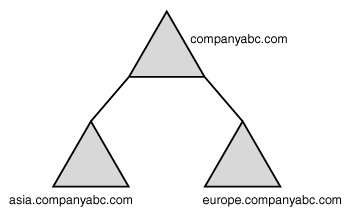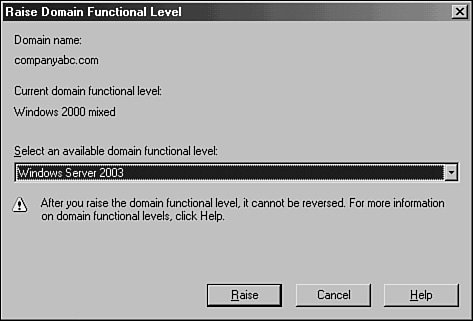Active Directory s Structure
Active Directory's StructureThe logical structure of Active Directory enables it to scale from small offices to large multinational organizations. Administrative granularity is built in to allow delegation of control to groups or specific users. No longer is the assigning of administrative rights an all or nothing scenario. Active Directory loosely follows an X.500 directory model but takes on several characteristics of its own. Many of us are already getting used to the forests and trees of Active Directory, and some limitations that existed before in Windows 2000 have been lifted. To understand Active Directory, we must first take a good look at its core structural components. The Active Directory DomainAn Active Directory (AD) domain is the main logical boundary of Active Directory. In a standalone sense, an AD domain looks very much like a Windows NT domain. Users and computers are all stored and managed from within the boundaries of the domain. However, several major changes have been made to the structure of the domain and how it relates to other domains within the Active Directory structure. Domains in Active Directory serve as administrative security boundaries for objects and contain their own security policies. For example, different domains can contain different password policies for users. It is important to keep in mind that domains are a logical organization of objects, and can easily span multiple physical locations. Consequently, it is no longer necessary to set up multiple domains for different remote offices or sites as replication concerns are more properly addressed with the use of Active Directory sites, which will be described in greater detail in the following sections. Note One of the key differences between AD domains in Windows 2000 and AD domains in Windows Server 2003 is that administrators now have the ability to rename domains. For this to occur, however, all domain controllers within the forest must be converted to Windows Server 2003 domain controllers and the Active Directory forest functionality levels must be raised to support Windows Server 2003. In addition, if Exchange is a part of the forest, the Exchange organization must be brought to Exchange Server 2003 Service Pack 1 levels before renaming a domain. A detailed discussion of the Active Directory domain rename tools is provided in Chapter 5, "Designing a Windows Server 2003 Active Directory." Active Directory Domain TreesAn Active Directory tree is composed of multiple domains connected by two-way transitive trusts. Each domain in an Active Directory tree shares a common schema and global catalog. In Figure 4.2, the root domain of the Active Directory tree is companyabc.com and the subdomains are asia.companyabc.com and europe.companyabc.com. Figure 4.2. A simple Windows Server 2003 Active Directory tree with subdomains. The transitive trust relationship is automatic, which is a change from the domain structure of NT 4.0, in which all trusts had to be set up manually. The transitive trust relationship means that because the Asia domain trusts the root companyabc domain, and the Europe domain trusts the companyabc domain, the Asia domain trusts the Europe domain as well. The trusts flow through the domain structure. Note Although trusts are transitive in a Windows Active Directory environment, that does not mean that permissions are fully accessible to all users or even to administrators between domains. The trust only provides a pathway from one domain to another. By default, no access rights are granted from one transitive domain to another. The administrator of a domain must issue rights for users or administrators in another domain to access resources within their domain. All domains within a tree share the same namespace, in this example companyabc.com, but have security mechanisms in place to segregate access from other domains. In other words, an administrator in the Europe domain could have relative control over his entire domain, without users from the Asia or companyabc domains having privileges to resources. Conversely, the administrators in Europe can allow groups of users from other domains access if they so want. The administration is granular and configurable. Caution As will become evident in later sections of this chapter, the domain is not the ultimate security boundary in AD; specific exploits that take advantage of the transitive trusts between domains in a forest make the forest boundary the absolute security layer. Forests in Active DirectoryForests are a group of interconnected domain trees. Implicit trusts connect the roots of each tree together into a common forest. The overlying characteristics that tie together all domains and domain trees into a common forest are the existence of a common schema and a common global catalog. However, domains and domain trees in a forest do not need to share a common namespace. For example, the domains microsoft.com and msnbc.com could theoretically be part of the same forest but maintain their own separate namespaces (for obvious reasons). Forests are the main organizational security boundary for Active Directory, and it is assumed that all administrators within a forest are trusted to some degree. If an administrator is not trusted, that administrator should be placed in a separate forest. Note Early on in the life of Active Directory, domains were considered to be its security boundary. Administrators within the forest did not necessarily have to trust each other and could be separated into domains. However, the January 2002 Microsoft Security Bulletin MS02-001 identified a vulnerabilty called the "Domain Trust Vulnerability." This vulnerability allows an administrator to use SIDHistory to elevate his privilege to any other domain in the forest. Although not easy to acomplish, it is still possible. SID filtering can be used between forests to prevent this attack, but not within forests. Thus, the security boundary for Active Directory was pushed from the domain to the forest. Active Directory Authentication ModesWindows NT 4.0 used a system of authentication known as NT LAN Manager (NTLM). This form of authentication sent the encrypted password across the network in the form of a hash. The problem with this method of authentication was that anyone could monitor the network for passing hashes, collect them, and then use third-party decryption tools, which effectively decrypt the password using dictionary and brute-force techniques. Windows 2000 and Windows Server 2003 utilize a form of authentication known as Kerberos, which is described in greater detail in the following sections. In essence, Kerberos does not send password information over the network and is inherently more secure than NTLM. However, Kerberos authentication is not required by default in Active Directory because AD is set up by default to be backward compatible for legacy Windows clients. Functional Levels in Windows Server 2003 Active DirectoryJust as Windows 2000 is installed to be initially compatible with legacy Windows NT domains and clients, Windows Server 2003 initially does not upgrade the Active Directory forest to Windows Server 2003 functionality. This helps to maintain backward compatibility with Windows 2000 and Windows NT4 domain controllers. Four separate functional levels exist at the domain level in Windows Server 2003, and three separate functional levels exist at the forest level.
To bring a Windows Server 2003 forest to Windows Server 2003 functional levels, perform the following steps:
When all domains and the forest level have been raised to Windows Server 2003 functionality, various Windows Server 2003 activities such as domain rename can be accomplished, and full realization of the Windows Server 2003 Active Directory capabilities can be achieved. Remember, before you accomplish this task, Windows Server 2003 will essentially be operating in a Mixed mode of compatibility, much as Windows 2000 initially ran in a Mixed mode with Windows NT Servers. |
EAN: 2147483647
Pages: 499

